|
|
|
This is purely a matter of interpretive logic rather than of physical or geometric science. To make matters of geometric and mathematical importance out of house cusps (beyond their defining axes) is, in my opinion, a fudge.
The Zodiac is divided into signs (or houses) from the equinox and solstice axes, and each Zodiac sign is observed to have different intrinsic energy, that energy being observed to change on or about the cusps which are placed at equal ecliptic longitude from the Cardinal axes on the traditional 12th (axial 6th) harmonic level.
This is a fundamental tenet of western astrology, and needs to be accepted as observable fact. This is an observation which has Universal significance, and all of the Equal house systems reflect this, without compromise or question.
The difference between the Zodiac and the Observer is that the Zodiac's defining axes are square, necessitating only one set of house cusps. The observer in relation to the Zodiac, has defining axes (MC / IC, Asc / Dsc) which are not usually square.
If an observer is to apply interpretive significance to both the Midheaven and the Ascendant , while maintaining the Universal principle of 30 degree house divisions, then two sets of house cusps must be drawn, one from each of the significant axes.
I have found the MC / IC axis to be interpretively useful in terms of the individual within their external environment, as a part of the 'collective whole' if you like.
I have likewise found the 10th / 4th Ascendant axis to be interpretively useful when describing the individual as a separate entity, The Ascendant marking the point of self awareness, in much the same way as the MC1st equal represents the way in which we are viewed by others.
All houses so derived are given more or less their traditional meanings, though the MC cusps are given an external application and the Asc cusps hold a purely personal focus.
The two sets of houses retain the integrity of the Universal significance of 30 degree cusps while accounting for the difference between the MC / IC axis and the Asc / Dsc axis. The difference between these axes is observed to be consistent with the difference (external experience of a given point compared to its internal application) with which the individual experiences cosmic energy.
The Dual Equal system has been used by only a handful of astrologers world wide. One reason for this may be the apparent complexity of this twin system.
Having used it for the past couple of years (and I am no neurosurgeon), I have found that the delineation provided by this system makes the interpretation of a chart much simpler, rather than more complex.
The chart itself is a little daunting to one who is not accustomed to it, but the style of information provided far outweighs the daunting appearance of the chart.
This is probably best done on a piece of paper with a compass, protractor, and square to start with. It is easier, in my book than trying to do this on a computer, although hopefully computer programmers will soon realise the advantages of this system and include it as an option in their astrology programs.
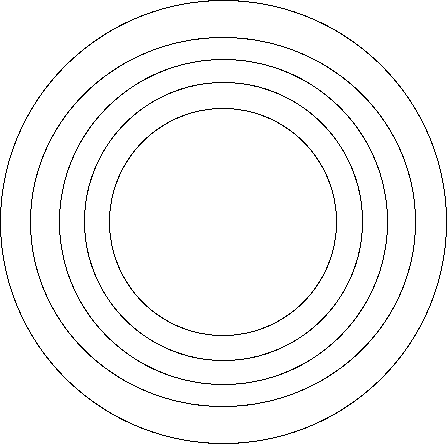
Resonant Axial Harmonics, born at 10.03 pm on Thursday, January 13, 2000 in Adelaide S.A.
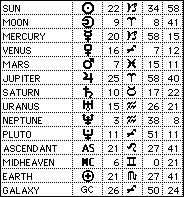
In the inner circle, and at the traditional 9 o'clock position if you like (orientation is an article of choice, but we will stay with tradition for the moment.) mark the Ascendant position. Mark house cusps at 30 degree intervals around the inner circle from the Ascendant. The cusps should be drawn from the inner-most ring, cross the next ring out, and stop at the middle ring. The reason for this will become apparent. Extend the Ascendant mark well beyond the rings for clear identification.
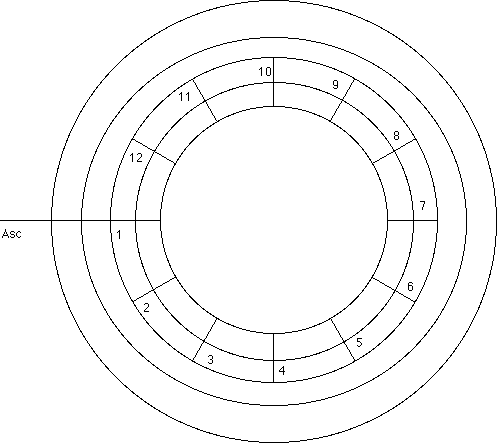
Mark Ascendant at traditional 9 o'clock position, and mark cusps at 30 degree intervals from there
To mark the Zodiac in the outer ring, find the value of your Ascendant in terms of degrees within the sign. In this case the value is 21 degrees 28 minutes, the sign is Leo. Measure the appropriate degree value above the Ascendant, and mark 30 degree cusps from this point. Fill the Zodiac signs in appropriate place and order.
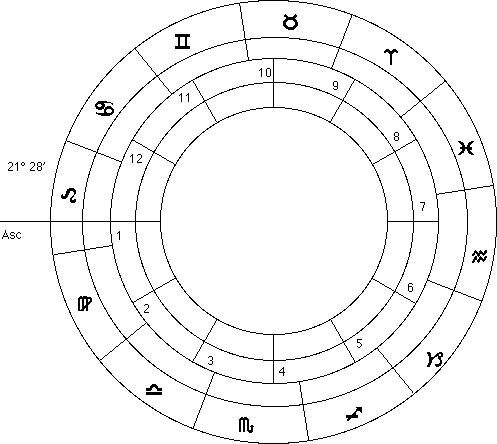
Your chart should have two sets of cusps at this stage, meeting on the middle ring but not overlapping.
Resonant Axial Harmonics, born at 10.03 pm on Thursday, January 13, 2000 in Adelaide S.A.

On the middle ring, mark the position of the Midheaven by its house and longitude with reference to the Zodiac signs you have just included. Mark house cusps at 30 degree intervals from the Midheaven. The house cusps should be extended one ring either side of the middle ring. The Midheaven mark should be extended well beyond the rings for clear identification.
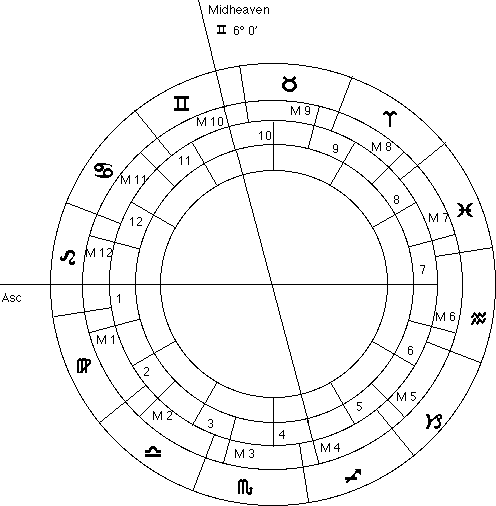
Locate position of MC and mark house cusps at 30 degree intervals from it.
Your chart should now resemble an irregular dart board, with each set of cusps overlapping into the next set so that clear delineation can be achieved.
Houses for both Midheaven chart and Ascendant chart should be marked in the traditional manner, with the Ascendant marking the 1st house cusp of its chart, and the Midheaven marking the 10th house cusp of its chart.
Resonant Axial Harmonics, born at 10.03 pm on Thursday, January 13, 2000 in Adelaide S.A.

Planets and chart objects can now be plotted in the inner ring (in Ascendant houses or inner circle, whichever you prefer.)
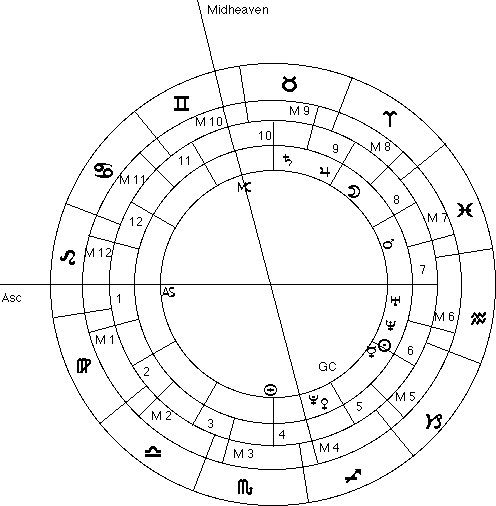
Save this chart at this stage as a template.
Once houses, planets, and objects are plotted, it pays to make several copies of the chart, as different investigations require different markings, and they cannot all be placed on a single chart without making an awful mess. A photcopier is ideal here, or a scanner / priter hookup. You may chose to fill the middle with aspect lines, I prefer not to do this.
Mark the primary axes of your planets to gain a feel for the diagnostic use of this style of chart
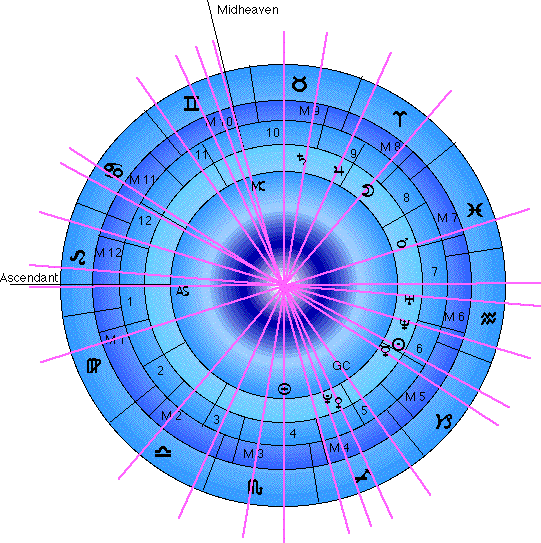
Resonant Axial Harmonics, born at 10.03 pm on Thursday, January 13, 2000 in Adelaide S.A.

On a clean copy of your chart, mark the primary axes of all chart objects so that the lines extend the total diameter of the outer ring (ie the axis runs through the centre of the chart and extends through the object. to both sides of the Zodiac). Extend them further if you like. These axes are the axes of resonance within your chart. The pattern is uniquely yours, and the relationships between those axes forms the mathematical basis for chart interpretation under Axial Harmonic Resonance©.
Unless your Angles are close to square, you should notice that some of your primary axes are in houses of different numbers for MC and Asc. If your Angles are particularly acute or obtuse, then there will be no 'common ground' between the houses at all. Every chart object now has a MC house and an Asc house, as well as its Zodiac sign.
By applying this method to hundreds of charts, Carl and I have made firm observations about the difference between the MC chart and the Asc chart. In similar fashion to their determinate factors, the MC chart is an expression of the native as he / she experiences the world, as part of the 'collective whole' of humanity. The Ascendant chart represents the native as a separate entity, an individual 'self' if you like.
Your primary axes marked on your chart display clearly the difference (if there is any) between your external experience of Cosmic energy, and your Internal experience of the same energy.
Anybody with an ounce of discernment who reads astrology charts can quickly divide the traditional fields of application of the houses into internal and external applications. These should now be given to their separately defined houses. If previous experience is anything to go by, you should find a consistent correspondence between your experience of Cosmic Energy, and this clearly defined house system.
Harmonic investigations use midpoint analysis, midpoints representing the area of application of a planetary pair, as well as its major trigger point.. This style of chart is ideal for clear delineation of midpoint application. I have found no better diagnostic tool in Astrology.
To have other Astrologers investigate this house system and put their observations to good use is the purpose of this exercise. Feedback is always appreciated, questions will be answered to the best of our ability.
© 1999-2000 Carl B. Smith and Rodney B. Smith. All information and artwork
in this website is copyright, including the terms Axial Harmonics, Axial
Harmonic Resonance, and Resonant Axial Harmonics, and may not be reproduced
in any form whatsoever, whether printed, photographic, electronic, or
otherwise, without prior written permission of the copyright owners, except
for fair purposes of review as permitted under copyright legislation.
Contact Carl B. Smith and Rodney B. Smith for more information.